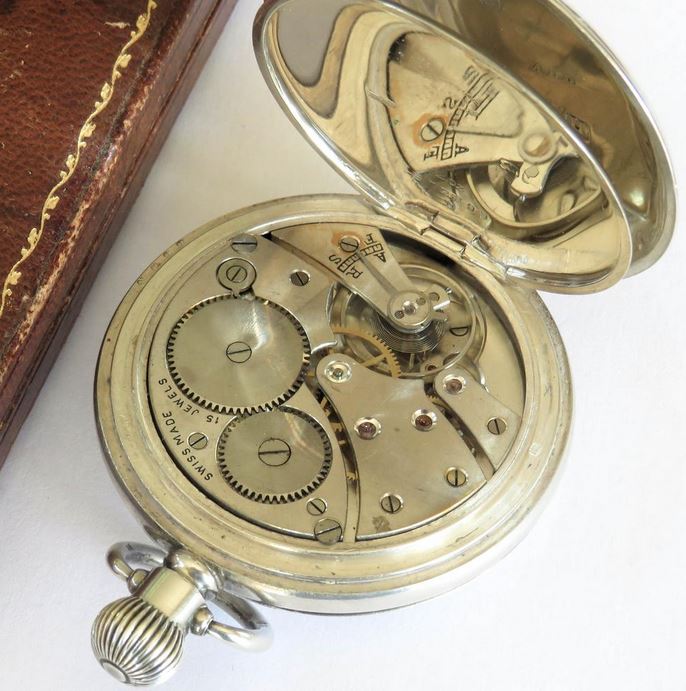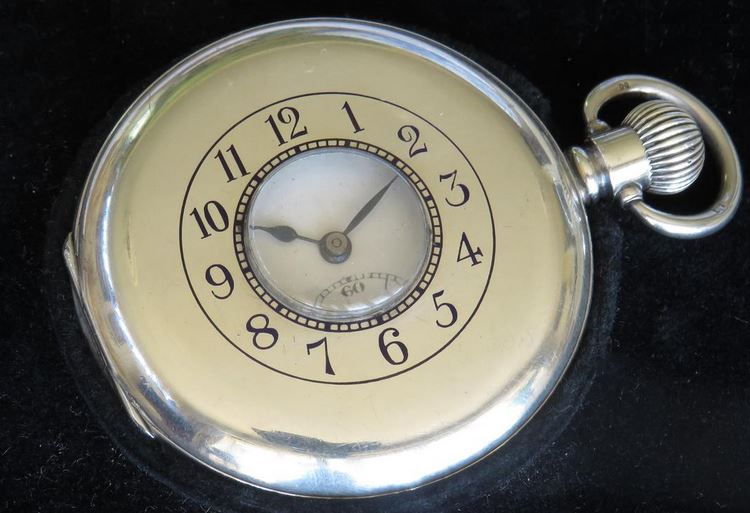Last updated on July 3, 2024
I am always looking to add a new antique watch to my collection. To begin with, it was easy to find a new timepiece, but over time as I learned more about antique watches my criteria became more stringent. In the early days of collecting, I was able to buy a piece every month or so, but now it has been about five months since my last purchase. I am looking for interesting timepieces that are presentable and practical. This means they should be in excellent or near mint condition and have a level of accuracy that makes them a reliable timepiece. I am searching for high-quality antique watches, but also for timepieces that I can enjoy researching. New watchmakers, different movement and case types, all give me something to investigate. In this instance, I took a look at a Revue half hunter pocket watch, 1919.
My collection predominately consists of open-faced pocket watches. I have a couple of trench watches and a hunter cased pocket watch. One of the case types that is missing from the collection is a half hunter pocket watch. Open-faced watches, as the name suggests, have nothing covering the pocket watch crystal. Full hunter watches have the crystal protected by a hinged cover that opens when the crown is depressed. They need to be opened to be able to read the time.
Half hunter
A half hunter pocket watch has a protective cover, but it includes a small glass window that allows the time to be read without opening the cover. The half hunter often has numerals on the case around the window to make it even easier to read the time. Half hunter pocket watches typically have a double spade hour hand that allows the hour hand to be identified through the window.

I saw this antique silver Revue half hunter pocket watch online and thought it might fill the gap in my collection. One of the things I enjoy about collecting antique watches is the research, so any time I find a watch with something new I get to expand my knowledge. This particular watch was from a manufacturer I was aware of, Revue, but I didn’t have one in my collection. The rhodium plating was also something I had not seen before.
Movement
The watch has a rhodium-plated Swiss made 15-jewel stem-winding movement, identified as by Revue, which is working nicely. A little wear to the rhodium on the regulator but nothing serious. The movement is protected by an inner hinged cover. Rhodium is a chemical element with the symbol Rh. It is an extraordinarily rare, silvery-white, hard, corrosion-resistant, and chemically inert metal. Rhodium has an extraordinary resistance to most acids and corrosive substances. It is one of the few white metals that will remain bright and reflective under all atmospheric conditions at normal temperatures. As a result, rhodium-plated surfaces remain scratch-resistant, bright and reflective for many years.

Gédéon Thommen
The “Société d’Horlogerie à Waldenburg” (Waldenburg clock and watchmaking company) was formed in 1853 to produce watches from ebauche movements. The company struggled with debt and the business was sold in 1859 to a local merchant, Gédéon Thommen from Waldenburg. After restructuring by Thommen, the company began to recover. Manufacturing and assembly methods were improved and importance was attached to the production of quality watches.
Gédéon Thommen renamed the company to “Gédéon Thommen – Uhrenfabrikation” (watchmaking). In 1870 Thommen patented an interchangeable component system. This ground-breaking patent allowed for the manufacturing of interchangeable watch components. This made it possible to transfer to an assembly-line production system. The new manufacturing methods had an immediate effect on production. In a new factory, in 1870, 4,000 watches were produced. By 1890 the output had increased to 13,000 watches per year. Thommen was becoming less and less dependent on suppliers, as the growing company could produce complete movement blanks in its own factory.
Revue
In 1890, Gédéon Thommen died as a result of a sudden illness. His son Alphonse took over the company. In 1905 Alphonse Thommen transformed “Gédéon Thommen – Uhrenfabrikation” into a limited company. The company would be called “Thommens Uhrenfabrik AG”. Additionally, in 1908, the brand name changed from GT to Revue.
The watch measures 51mm in diameter excluding the winding stem and the loop. The case is silver and there are hallmarks inside the two case backs for Birmingham 1919 with a maker’s mark for the Birmingham case maker Aaron Dennison. The front cover has hallmarks for Birmingham 1933 so a later replacement, probably to replace a damaged front cover. However, the watchmaker doing the repair sourced the replacement from Dennison’s so everything has the same maker’s mark.
The Dennison Watch Case Company
Aaron Dennison (1812 – 1895) was an American-born businessman. He trained as a watchmaker and had a chequered career in the watch industry. He worked for several watchmaking companies, including one that was to eventually become the Waltham Watch Company. In 1864, Dennison set up another business, the Tremont Watch Company in Boston. He intended to use components from Swiss manufacturers because labour costs were lower. Dennison left a business partner in charge in Boston and moved to Switzerland to oversee operations. The Tremont Watch Company fell into financial difficulties in 1870. As a result, Dennison moved to England. In 1874, he founded the very successful Dennison Watch Case Company in Birmingham.
Originating from a small workshop on the side of the family home, the company was called Dennison, Wigley & Company and it grew to produce 100,000 high-quality watch cases per year. Dennison died in 1895, and he was succeeded in business by his son, Franklin Dennison. The company was renamed the Dennison Watch Case Company Ltd in 1905 and continued as a successful business until 1967.
Half hunter cover
The front cover has a small central lens surrounded by enamel filled hour markers. Overall, the case is in good condition with just a minor “ding” by number 2 and the odd small mark. The winding crown pushes in to open the front cover. Inside there is an acrylic lens that has a 2mm scratch, but otherwise is in good condition. The gold-plated bezel is a later replacement.

The dial is in very nice condition with original blued steel hands. Bluing steel is a process that tempers the steel and creates an oxidised coating that helps to prevent the hands from rusting. Initially, the steel hands are cleaned and polished. Next, the hands are heated, over a bed of brass filings, to a high temperature. The layer of brass filings is used to maintain a stable temperature exchange. The steel changes colour from gold to brown and then purple before it settles to blue. The watch comes in an antique presentation box. The watch is running within +/- two to three minutes over a 24 hours period.
Conclusion
There are several things to avoid when you are collecting antique watches, such as non-original components, corrosion and damage. I collect antique watches for enjoyment, not as an investment. However, I am still mindful of only collecting pieces that would be valued by other collectors, otherwise when it comes to resale, I might be disappointed. This watch looked great at first sight but has a couple of underlying issues. My concerns are the replacement half hunter cover and the wear to the rhodium plating. Even though it is the same case maker, the cover is clearly not original. The mild wear to the rhodium plating on the regulator suggests that the regulator has seen a lot of use. The Revue half hunter pocket watch is a presentable and accurate timepiece, so I am sure it will find its way into a delighted owner’s hands.